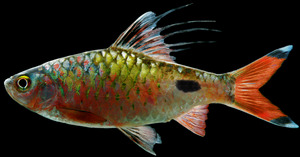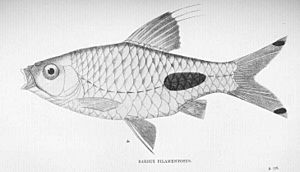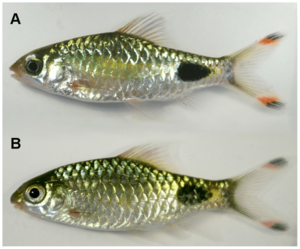Filament barb facts for kids
Quick facts for kids Filament barb |
|
|---|---|
 |
|
| Conservation status | |
| Scientific classification | |
| Synonyms | |
|
The filament barb, also known as Dawkinsia filamentosa or poovali paral, is a type of fish. When they are young, these fish have very little color and some black spots. They start to get more colorful when they are about three months old.
These fish are very fast swimmers. Male filament barbs are bigger than females. They fertilize the eggs by swimming into the cloud of eggs. You can usually find this species in coastal areas near rivers in the Indian states of Kerala, Tamil Nadu, and Karnataka. It is also sometimes called the blackspot barb.
Contents
What's in a Name?
The name of this fish, Dawkinsia, comes from a famous British scientist named Richard Dawkins. He is known for helping people understand evolution and how living things change over time. The fish was named after him to honor his work.
How to Spot a Filament Barb
Adult filament barbs have some special features that help tell them apart from other fish in South Asia.
- Adult males have long, thin extensions on their back fin that look like filaments.
- There is a black band near the tip of each lobe of their tail fin. This band is about as wide as the fish's eye.
- They have a black spot on their body, usually covering 2 to 5 scales, starting behind their anal fin.
- Their lower lip is continuous, meaning it doesn't have a break.
Where They Live
The filament barb is found only in a specific area of southern India. This area is called the Western Ghats mountains. You can find them in the states of Kerala and Tamil Nadu. They might also live in the southern part of Karnataka.
The first place where this fish was officially found and described was 'Alleppey'. This town is also known as Alappuzha. It is located in Kerala, between Vembanad Lake and the Arabian Sea.
Their Home Environment
These fish usually live in lowland coastal areas that are often flooded. They can be found in both fresh water and slightly salty water, known as brackish water. Their homes include rivers, estuaries (where rivers meet the sea), coastal marshes, and reservoirs (man-made lakes).
Fishing for Filament Barbs
Along the rivers in Kerala, filament barbs are very common. They eat a lot of worms and insects. This makes them easy for fishermen to catch using bait. They are especially common during the monsoon season when there is more water and they are found in more places.





